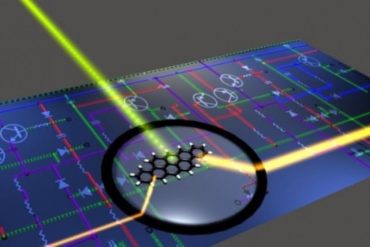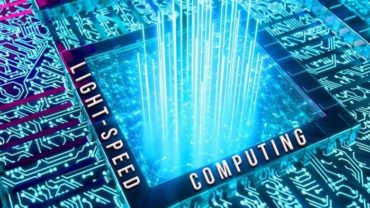Optical Technology: Optical Transistor That Might Replace Electrical Transistor

History Of Electrical Transistor And Its Development
In 1954 the first silicon transistor was comparable in size to the US. In 1965 co-founder of Intel, Gordon Moore, predicted the number of transistors fitting onto a chip doubling every two years. This prediction was later called Moore’s Law and was very accurate up through the beginning of the 21st century. While the exponential growth predicted hasn’t stopped completely it has slowed down. Today silicon transistors rapidly approach ~10nm across, the theoretical minimum size for electron-based computing. This limitation is due to the quantum nature of electrons, where the electron can simply tunnel through the transistor as if it weren’t there. The 5nm minimum size imposes a maximum number of transistors and maximum speed of computation. This limitation can be mitigated by parallel processing, or multiple processors running in tandem, but this in turn generates more heat and is difficult to program for. Current chips are made with a two dimensional model, they could be made three dimensional to increase possible number of transistors but this increases cooling problems (cooling is related to surface area, a cube has much less than a chip of similar volume), power consumption, as well as tunneling issues as before.
Electrical Transistor In Everyday Life
In our modern society, extensive use of electricity has enabled various uses of transistors in every electronic circuit. Transistors are used in our day to day lives in many forms which we are aware of as amplifiers and switching apparatus. As amplifiers, they are being used in various oscillators, modulators, detectors and nearly in any circuit in order to perform a function.
How does optical technology for transistor works
The optical transistors are not powered by electricity, but by pumped lasers; that is, violet laser beams (at the 400-480-nanometer wavelength) continuously modulate between high- and low-power outputs, which are interpreted as logical 1s and 0s. A second, smaller laser beam—functioning in lieu of an electronic gate—switches the pumped laser on and off to produce the desired output of 1s and 0s.
Optical vs Electronic

Encoding information in light differs profoundly from doing so using charge. For one thing, electrons exert strong forces on each other, making it easy to manipulate them and to arrange the interactions that enable logical operations. By contrast, photons of light travel long distances without interacting, which makes massive parallelism easier, but means that logically combining two light signals generally requires an intermediary material. Although computing at the speed of light seems impressive, the electromagnetic impulses in ordinary computers propagate essentially as fast.
What actually slows electrical signals is the time needed to charge the wiring capacitance. This charging also stores energy that is usually discarded when the next signal comes along. Because the energy of photons does not depend on how far they travel, they have a power advantage for long-distance connections where the savings overcome the energy costs of generating them in the first place.
Previous state of optical technology
In the past optical technology has downsides, although it’s excellent over long distances (such as in fibre optic data transmission), it quickly loses energy at short distances compared to using electrons. Light is currently better at 3 m (10 ft) or more, a scale that is rather large and impractical when it comes to a desktop computer or laptop. Not only that, future devices may require as small as ten auto joules which are demanding targets for optical technology since operational energy represents total energy for the total logic operation and not the input signal energy.
Latest Optical Technology for transistors.
Last month, in September 2021, An international research team led by Skoltech and IBM created an extremely energy-efficient optical switch that could replace electronic transistors in a new generation of computers manipulating photons rather than electrons. In addition to direct power saving, the switch requires no cooling and is really fast: At 1 trillion operations per second, it is between 100 and 1,000 times faster than today’s top-notch commercial transistors.
future devices may require operational energies demanding targets for an optical device to reach, particularly because they represent the total energy for logic operation, not just the input signal energy.

Advantages of This Technology
It uses a photon, the smallest particle of light that exists in nature to make it work. Because of it, there is really not much room for improvement beyond that as far as power consumption goes.Most modern electrical transistors take tens of times more energy to switch, and the ones that use single electrons to achieve comparable efficiencies are way slower.
In addition to its primary transistor-like function, the switch could act as a component that links devices by shuttling data between them in the form of optical signals. It can also serve as an amplifier, boosting the intensity of an incoming laser beam by a factor of up to 23,000.
Possible implementation of optical transistor
Although currently there’s none of the everyday computing based technology that are commonly used there are some technologies that are similarly using the same theory and also some other possibilities.
1. Optical keyboard
The optical switch uses light induction to trigger the switches. It works with the mechanical switch to block the light beam. When the switch is pressed, the stem of the switch moves downward, triggering the light sensor on the PCB and activating the key. That’s why optical switches are faster than the traditional switch as no physical contact is needed to send an electrical signal; eliminating the need for a debounce delay. Also, because there is no physical contact, these switches are usually more durable. The lifespan of the traditional switch is 50 million key presses while the optical switch can double that life span and can last 100 million.

2. Optical Computer
An optical computer (also called a photonic computer) is a device that uses the photons in visible light or infrared ( IR ) beams,rather than electric current, to perform digital computations. An electric current flows at only about 10 percent of the speed of light. This limits the rate at which data can be exchanged over long distances, and is one of the factors that led to the evolution of optical fiber . By applying some of the advantages of visible and/or IR networks at the device and component scale, a computer might someday be developed that can perform operations 10 or more times faster than a conventional electronic computer.

3. Artificial Intelligent
Artificial Intelligence (AI) neural networks are being touted as one of its great applications, with the potential to achieve 10 million times greater efficiency than electronic systems. Statistical workloads such as those employed in AI algorithms are perfectly suited for optical computing.

References
- https://byjus.com/physics/uses-of-transistor/
- https://www.futuretimeline.net/blog/2021/09/24-optical-transistor-future.htm
- https://www.researchgate.net/publication/40764874_Are_optical_transistors_the_logical_next_step
- https://cacm.acm.org/news/238930-organic-optical-transistor-outperforms-silicon/fulltext
- https://scitechdaily.com/new-extremely-energy-efficient-optical-transistor-speeds-up-computation-up-to-1000-times/
- https://eng.libretexts.org/Bookshelves/Materials_Science/Supplemental_Modules_(Materials_Science)/Optical_Properties/Optical_Computing
- https://www.tomshardware.com/news/goodbye-transistor-new-optical-switches-offer-up-to-1000x-better-performance
- https://cacm.acm.org/magazines/2014/10/178773-still-seeking-the-optical-transistor/fulltext
- https://www.ibm.com/blogs/research/2019/05/ultrafast-optical-room-temperature-transistor/
- https://spectrum.ieee.org/optical-switch-1000x-faster-transistors
- https://www.bbvaopenmind.com/en/technology/future/optical-computing-solving-problems-at-the-speed-of-light/
